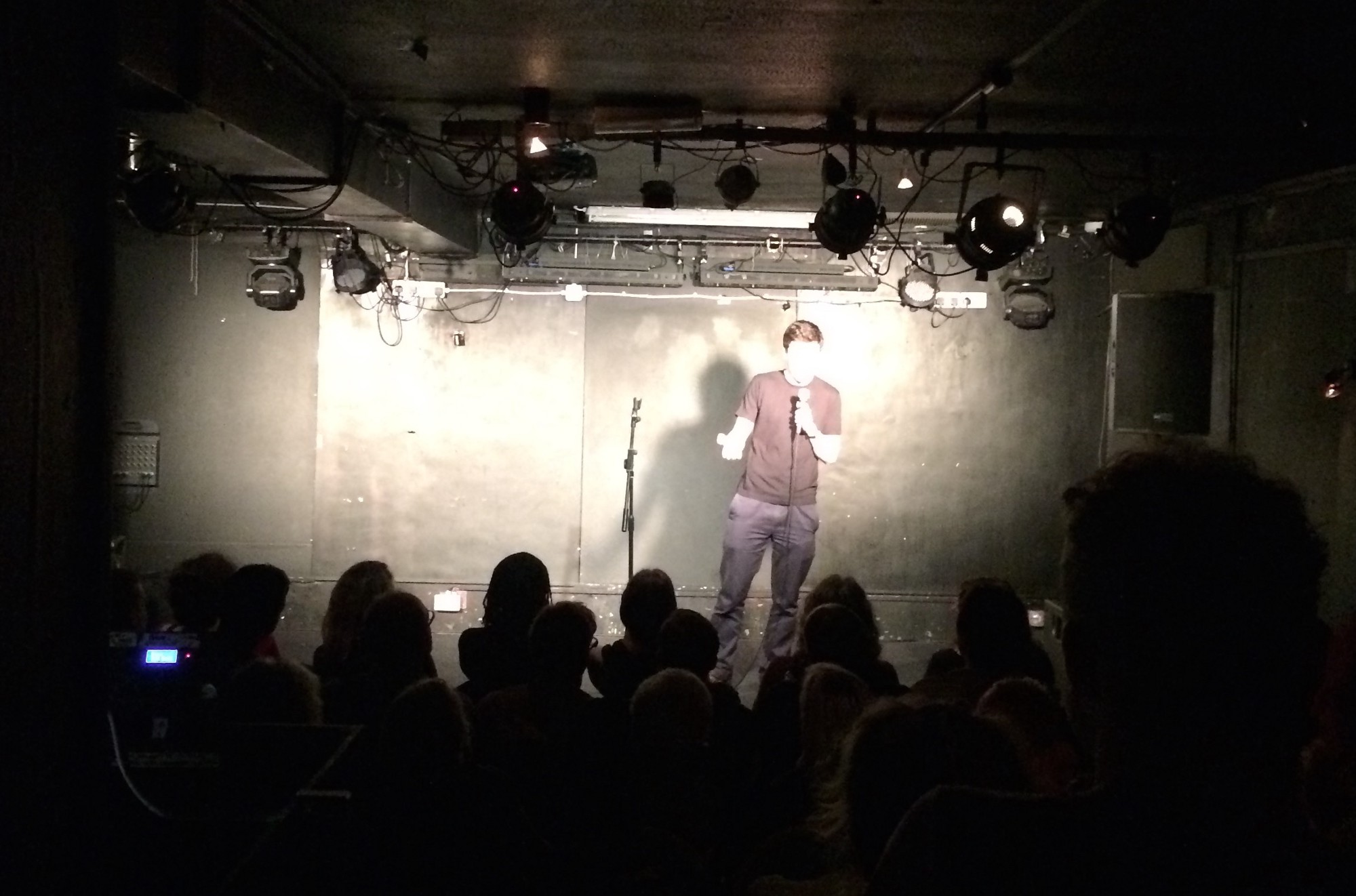
On 14th November, in a packed out upstairs room in a pub near London Bridge, I was about to get on stage and deliver my first set of stand up comedy. After a wink from the MC, I stepped on stage, took a deep breath, and let the supportive cheers from the audience die down as I cleared my throat to begin to speak.
The seeds of this moment were sown eleven weeks previously, during a pub conversation with friend, Ed Gotham, and in the next 5 minutes, I was either going to wither, or blossom…
Let’s do an activity
In The Argyll Arms near Oxford Circus after an evening of catching up, Ed and I spoke about what activities we could do that would be challenging, but also have some secondary benefits to our professional lives.
Learning a new language seemed too mainstream, coding too work-related, and sushi-making too non-transferable. Ed was equally unimpressed by my suggestion of floral arrangement. However when we discussed public speaking, the case against started to dissolve. Keen to take it one step further, the idea evolved into doing a stand up comedy course.
Why stand up comedy?
- Learn to keep an audience engaged
- Feel comfortable speaking to large groups
- Meet interesting people
Once we spelled this out, it became clear that (should we be able to find a course) this would be a small time commitment that we could keep each week, and come to the end feeling that we’ve done something a little different.
I undertook some research, found options, spoke with Max Dickins (who delivered the classes) and signed up myself and Ed to the Hoopla Stand Up Comedy Classes to start in a few weeks’ time.
How the course worked
The content and delivery were fantastic, despite the classes being held in the back room of a travel agent’s office in Shoreditch.
The format each week was more or less the same. The group of 14 would arrive at 7pm and do the following:
- 20 minutes or so completing warm up exercises
- 30 minutes discussing a comedic subject
- 10 minutes break
- 45 minutes performing our sets
- 10 minutes group feedback
Warm up exercises
This basically involved us standing in a circle, allowing silly noises to come out of our mouths, and periodically jumping around. Games included “Whizz Bang”, “Bunny bunny”, “Un lapin, un lapin”, and “The Japanese Sumo Warrior Game”
Comedic subjects
To broaden our knowledge of how the comedic craft is structured we would dive into a new topic each week. This included presenting short television pitches for ludicrous ideas, de-constructing jokes to see why they are funny, and how to be charismatic on stage.
The other day I saw a baby ghost lying on the floor… either that, or it was a handkerchief
This Milton Jones joke was the foundation for how I approached finding funny things out of everyday activities that usually pass us by.
Break
Well.. yes..
Performing our sets
This was the meat of the class each week. Homework from last week was always to deliver a brand new 2 minute set. We’d often use the lessons and techniques from the previous class to help craft our material for the upcoming week, whether that be going into minute detail of a subject, or deliberately presenting an opposite opinion to conventional wisdom.
Every week, each performer got a rapturous welcome, and a standing ovation. The rest of the class sat “in the audience” and watched our friends on stage.
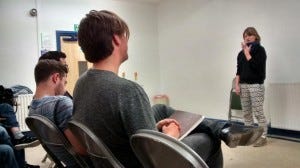
One thing Max stressed was that we’re here to learn. None of us are going to be able to deliver a flawless performance, only a few weeks into learning a craft. But by committing to each week come up with new material, experiment with new techniques, and going through the motions of standing on stage and looking the audience in the eye, trying to engage them and make them laugh, you will continue to get better
If you improve 5% each week, by the end of 8 weeks you’ll be… you know… x% better
And it was true. One of the side benefits of coming every week was seeing how each person was improving, and making us laugh more and more with each passing Wednesday.
Group feedback
Arguably this was the most valuable.
Before setting off to the pub, we would gather in a circle and openly go through each person’s performance. Max would say what was good, what could be improved on, and anyone else would chime in with their thoughts.
This was also an excellent opportunity for Max to inadvertently demonstrate his skill as a comedian; spotting opportunities for jokes where we had struggled, and gone down another path. I always found it a pleasure to witness a professional in action in this informal way.
The two hours at Hoopla were unlike any other two hours in my week
It required me to take my brain to places that were never stretched as much in my everyday life. For this reason, I always relished my Wednesday evenings with the group
Creative thinking
One thing I hadn’t accounted for was the level of creativity needed to generate original content each week. Nevertheless, I absolutely loved it.
Each person took a different approach to being funny, which was clear from the diverse range of performances we saw each week. My method for creating a new routine largely followed a format of:
- Keeping note of funny thoughts throughout the week
- At the weekend, setting aside two hours
- Writing the disparate ideas on a page
- Find connections between them
- Write out a narrative in note form, with arrows where I expected a laugh
- Condense into a page in my notebook, to read to remind myself
Then, if I had time, I would read the notebook page on Monday and Tuesday to refresh my memory. Before heading to the class on Wednesday evening, I would run through the performance in my head, so that I knew roughly what I was saying.
It’s difficult to answer how I would “come up with material”. However typically I would make an effort to look at something that everyone could relate to, and then spend 10 minutes thinking up everything I could about it.
In the process, there would be some interesting insights that come out of this exercise which, with enough nurturing, could be made into something funny.
For example, cycling home from the class I passed an ambulance outside the Royal London Hospital. The cogs started turning in my mind, and I realised that I knew very little out about how this iconic vehicle operated, because I had never been inside one. This led to the realisation that I’d never called 999, and formed the basis of my final set.
Be true to yourself
One thing that attendees of the final performance commented on was the diversity of acts. Max had always been very open about how each person has an individual humour, and so he wouldn’t teach people particular techniques like “The Rule of Three”, as you’d then get 14 identical acts on stage, which gets tiresome for the audience, and also means that you’ll be forever mimicking another comedian.
In fact, Max brought this out after week two. In my first set, I had done a story about how an old lady was wearing a “lad” T-Shirt saying “Made To Be Laid”. As part of the routine, I pondered what sort of a company would make such a T-Shirt, and how did it end up in the possession of this meek elderly woman.
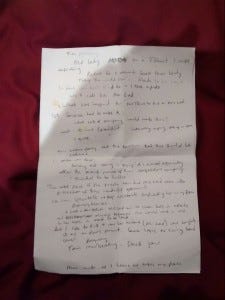
Notes ahead of first 2 minute set
I whipped out my iPad, and started reading the Terms & Conditions of the website, gleaning humorous references. After the set, Max asked me if I liked Stewart Lee, to which I nodded “he’s probably my favourite comedian”.
“I can tell.”, he said, “Don’t watch any more videos of him”. The reason for this advice was that I was (subconsciously or not) imitating the experienced comedian. Any originality I had was tarnished by being in the style of someone else, and undermined the work that I had done.
Max recommended to all of us that we stay true to ourselves. Be vulnerable, reveal your inner thoughts, because in truth comes some of the funniest material. It also allows you to carve your own route, rather than being a bit-part shadow of someone more well known.
The Lean Standup
The other main bit of feedback I received had loud echoes of my work on the New Entrepreneurs Foundation.
Keep it lean
In the world of startups there are certain bits of advice that continue to surface. The central theme is to strip away the fat, and focus on the core of what you are trying to do. Don’t bother with superfluous details, or amusing distractions, instead — stay on track with the essence of what it is you are trying to communicate.
I have also found that the process of coming up with creative content each week has done wonders for my idea generation.
Forcing yourself to see everyday objects from a completely different perspective means that you start solving problems in creative ways. As part of the course we would regularly be asked to vehemently argue to the opposite of common sense
- Why being ill is great
- Why charities are terrible
- Why people should stop giving birthday presents
This idea of approaching a topic from a completely new angle is, as far as I can see, an excellent tool for aspiring entrepreneurs. In order to truly innovate, one must be contrary to popular belief, and persuade people that they should change how they do things.
Whilst it is fun arguing (in the third instance) that wrapping paper would be better used as wallpaper in bland buildings, it is also the bedrock of inventive thought — essential in the creative process.
Another example is that I gave myself the challenge of answering how estate agents calculate whether an area is “up and coming” or not, and ended up discussing the density of fried chicken shops in the neighbourhood.
Preparing for the final performance
The previous Saturday, I spent the morning sprawling out my thoughts from the previous eight weeks. In the absence of any paper in the flat, and took a cardboard box, and wrote my five funniest stories on the different panels
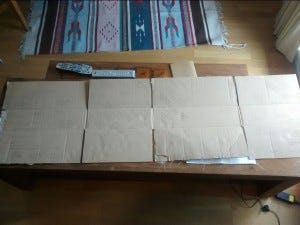
Notes of the final gig (no paper in the flat)
For the next couple of hours I started writing out themes of the stories, and then finding connections from the other amusing observations that I’d made. I was able to link up seemingly unrelated sections by finding a common thread, and also write jokes that fitted in along the way.
When I was happy with the cardboard, I left it out, and went for a run.
The next evening I wrote out, word for word, what the set would sound like, and then timed myself speaking it. Being a couple of minutes over, I adopted the “keep it lean” approach, and lost of the more flabby material, reducing it down to two key stories, with a tight segue in the middle.
Each morning that week I woke up early, practised it, refined it, and visualised myself on stage. I left work at 6pm on Friday evening, and walked over to The Miller, reciting what I was going to say, and then met up with the rest of the group in the upstairs room.
The gig
On the Friday evening, the eight other performers before me absolutely nailed it. The crowd was having a good time, and I was very grateful to have a solid gathering of friends there to cheer me on, as I stepped up to the mic.
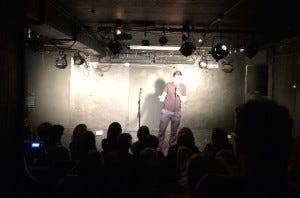
I got on stage and, partially blinded by the lights, got my first joke out of the way (calm the nerves) and started explaining to the room my slightly tongue-in-cheek opinions about house valuation and the perils of running out of milk.
The audience were very warm, and even on the less funny points, gave vocal laughter, which was a great lift. On stage, some things I thought were funny, weren’t received as well, and things I thought were just a “throwaway joke” ended up getting big laughs.
Either way, when I finished my set, I felt that I hadn’t let down the guys who had come along this evening, so for that reason I was very happy.
The rest of the evening was spent congratulating everyone else on their superb sets, and catching up with my friends who had come along.
Conclusion
When I think back to discussing stand up comedy with Ed in the pub, the outcome is exactly what we were after. I have added to my experience of engaging groups of people, and really enjoyed the creative process of writing comedy.
Many people I have spoken with have asked whether I will continue doing it. It’s not something I had really considered, and so I might come back to it in the new year, in which case — keep an ear out — and come along.
If you too would like have a go, then (as I hope you can tell) I would highly recommend it. I am happy to chat if you have any questions.
The Hoopla course, and being taught by Max, has been fantastic. You can sign up for their next one by clicking here.